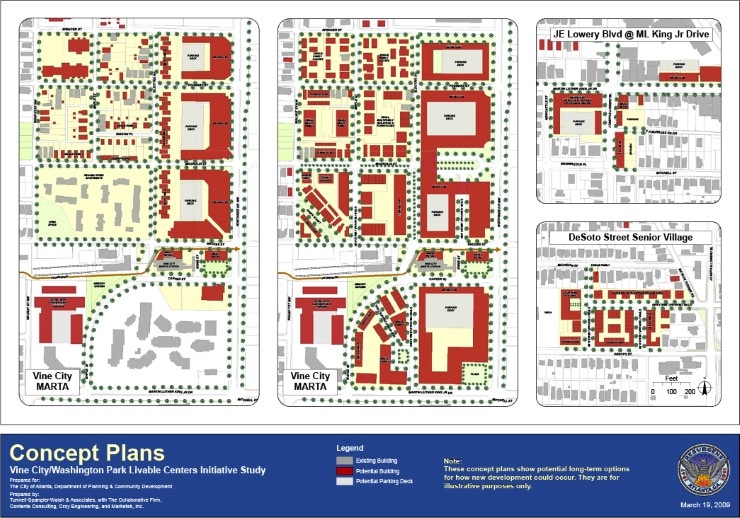|
In early 2009, TSW lead a six-month public process to develop a comprehensive plan for the Vine City and Washington Park neighborhoods. The study was funded by the Atlanta Regional Commission’s Livable Centers Initiative (LCI) program, and focused on creating a vision for integrating transportation and land use.
Most of the study area lies less than one mile from downtown Atlanta. It faces many of the problems of historic urban neighborhoods suffering from a lack of investment. A high number of foreclosed properties and vacant lots, underutilized transit stations, and public safety were key stakeholder concerns.
TSW, as head of the consultant team, led area residents, businesses, community leaders, and others through a series of public meetings and a half-day workshop to discuss solutions to the challenges faced by the area. Using the comments from the workshop as a guide, the team developed recommendations, including:
- Vine City Station Transit-Oriented Development. This underutilized transit station could benefit from new higher-density, mixed-use development that respects the scale of the historic neighborhood and adds public space.
- Promenade Multi-Use Trail. The facility would connect the study area with downtown Atlanta to the east and the existing Westside trail to the west.
- Nodal Mixed-Use Development. Changes to the City of Atlanta future land use plan will encourage street-oriented, mixed-use buildings at transit stops and near major intersections.
- Streetscape Improvements. The study recommends that major roads within the study area have repaired sidewalks, new street trees, better lighting for increased safety, and new bicycle lanes in many areas.
- Urban agriculture. Community gardens and farmers markets will create jobs, encourage the use of vacant lots, and bring neighbors together.
 The study also included strategies for intersection improvements, pedestrian enhancements, code revisions, economic development, and housing. Its recommendations were approved by all appropriate neighborhood associations and Neighborhood Planning Units, thanks to an inclusive public involvement process. The study also included strategies for intersection improvements, pedestrian enhancements, code revisions, economic development, and housing. Its recommendations were approved by all appropriate neighborhood associations and Neighborhood Planning Units, thanks to an inclusive public involvement process.
|


 The study also included strategies for intersection improvements, pedestrian enhancements, code revisions, economic development, and housing. Its recommendations were approved by all appropriate neighborhood associations and Neighborhood Planning Units, thanks to an inclusive public involvement process.
The study also included strategies for intersection improvements, pedestrian enhancements, code revisions, economic development, and housing. Its recommendations were approved by all appropriate neighborhood associations and Neighborhood Planning Units, thanks to an inclusive public involvement process.